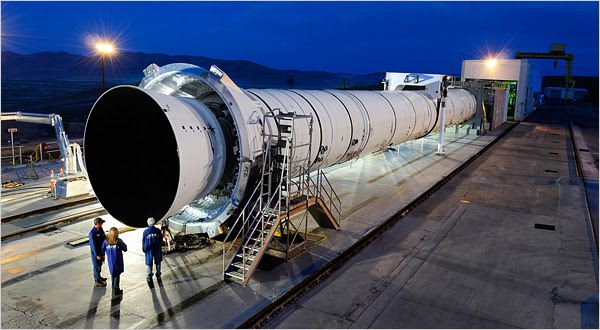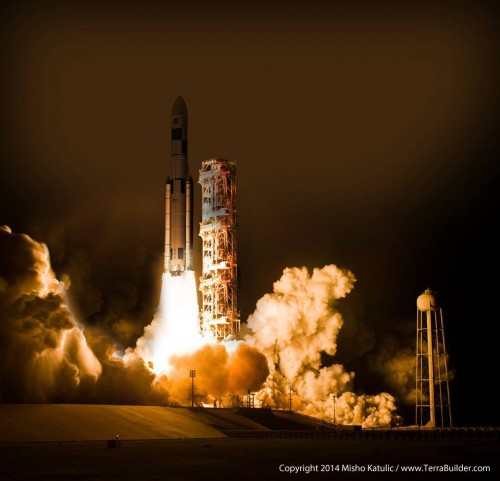
When NASA’s giant 320-foot-tall Space Launch System (SLS) rocket flies its first unmanned Orion/SLS flight test in 2017, one of the most noticeable—if not the most noticeable—characteristics of the launch will be the incredibly bright fireball and thick plume that will follow the rocket up during its ascent toward space. Four powerful liquid-fueled RS-25 engines on the SLS won’t be enough to get the job done, though; SLS simply needs more power in order to deliver the 70 metric tons (154,000 pounds) to orbit that NASA expects to fly on the initial SLS missions.
That’s where ATK and their five-segment solid rocket boosters (SRB’s) come in to play: the critical extra “push” SLS needs to break away from Earth’s gravity to send astronauts on deep space missions of exploration. This week the Utah-based SLS booster supplier completed the Critical Design Review (CDR) for the boosters, which will be the largest human-rated solid rocket motors ever to fly.

“Achieving this milestone is a tremendous accomplishment for ATK and NASA as we continue building the boosters for America’s Space Launch System,” said Charlie Precourt, vice president and general manager of ATK’s Space Launch division. “Deep space exploration requires a heavy lift vehicle, and SLS is the only vehicle with the mass, volume and speed required for human missions to destinations such as the moon, an asteroid or Mars.”
The five-segment motor is based on the space shuttle’s four-segment boosters, which were also provided by ATK, but the new version for SLS has been upgraded to incorporate new materials and technologies and will provide 30 percent more power than the boosters which launched NASA’s now retired shuttle fleet.
According to ATK, each motor will consist of five rocket motor segments, thrust vector control, and an aft exit cone assembly (153 feet long and 12 feet in diameter). The entire booster, including nose cap, frustum, and forward and aft skirts, will be approximately 177 feet long, and of the booster’s 1.6 million pounds total weight, the propellant alone will account for 1.4 million pounds.
If the heat energy of ATK’s five-segment SLS boosters could be converted to electric power, the two SRBs firing for two minutes (which is how long they burn before going dry) would produce 2.3 million kilowatt hours of power, enough to supply the entire power demand of over 92,000 homes for a full day.
Having now completed the CDR, ATK’s SLS booster design can now proceed toward qualification testing. According to ATK, the booster avionics qualification efforts are also in work and will be incorporated into the vehicle qualification effort, which is scheduled for completion in 2016.

“ATK’s technology innovation, process improvements and lean manufacturing will enable SLS to deliver humans and cargo to deep space faster, safer and more affordably than any other existing or planned vehicle,” said Precourt, who is also a four-time space shuttle astronaut. “It is exciting to see that the teams working on SLS and the Orion crew capsule are all making steady progress toward NASA achieving a human mission to Mars by the 2030’s.”
A full-scale ground static firing of the booster, Qualification Motor-1 (QM-1), is planned for late this year/early next year at ATK’s facility in Promontory, Utah. The next major booster milestone will be the Design Certification Review scheduled for fall of 2016.
ATK booster avionics and control tests were completed in December 2013. Booster avionics test was completed April 3, 2014, and completion of a significant structural test of the booster’s main attachment mechanism, the forward skirt, was completed May 20, 2014.
Although ATK is tasked with providing the SRB’s for at least the first two SLS flights in 2017 and 2021, later missions on the evolved SLS, which would be able to carry 130 Metric tons (286,000 pounds) to orbit, may fly on liquid-fueled boosters.
Want to keep up-to-date with all things space? Be sure to “Like” AmericaSpace on Facebook and follow us on Twitter: @AmericaSpace



